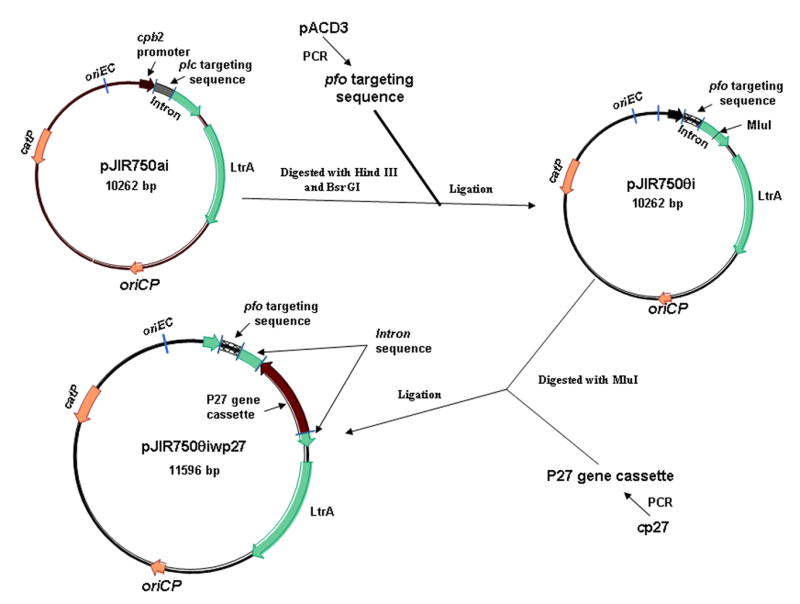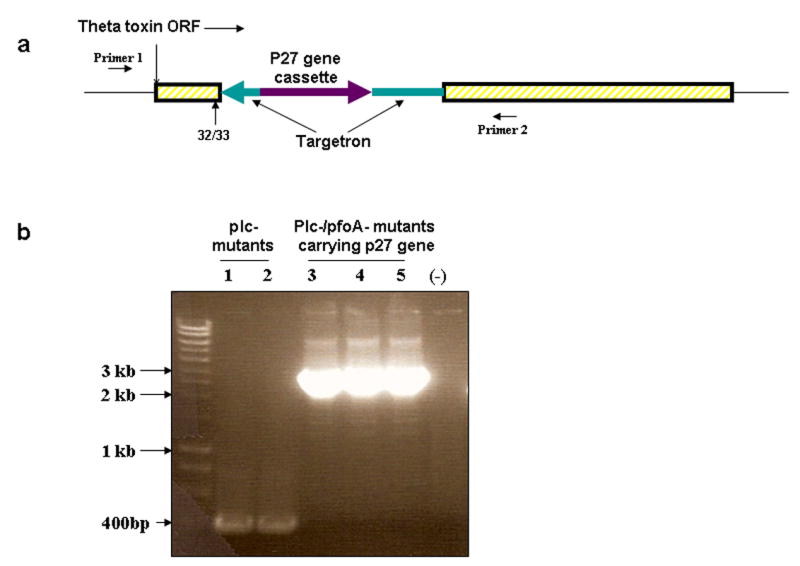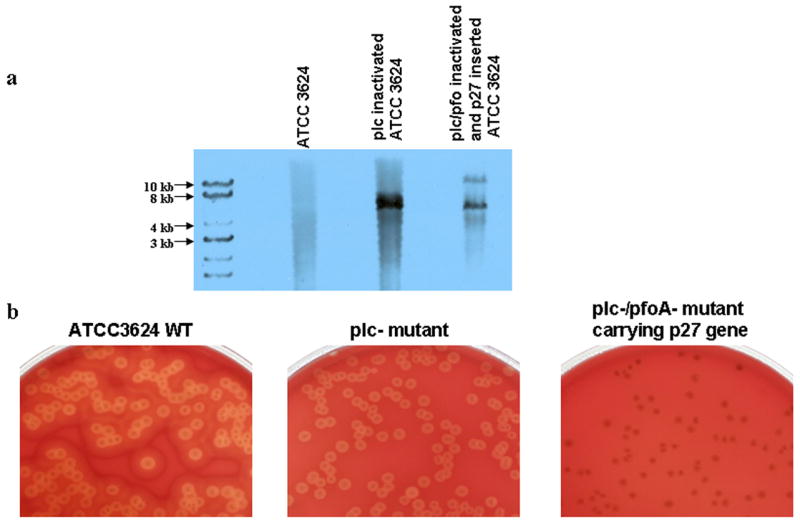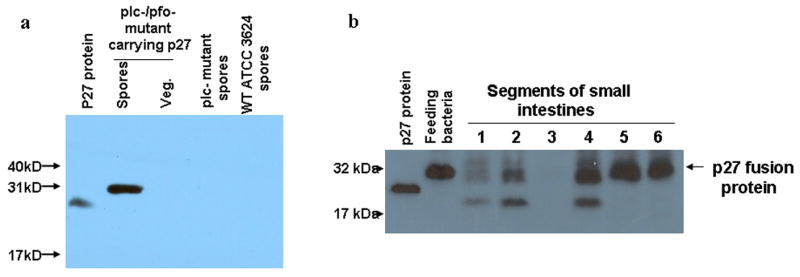Abstract
Clostridium perfringens (C. perfringens) has been developed as a potential oral delivery vehicle to deliver antigens or therapeutic compounds to Gut Associated Lymphoid Tissue (GALT). However, this recombinant C. perfringens carries a plasmid-encoded expression system, which raises several safety concerns regarding possible horizontal plasmid transfer and spread of plasmid-associated antibiotic resistant genes. Furthermore, this bacterium produces the extracellular theta toxin, which poses a potential safety issue for general administration. Using a Clostridium-specific-targetron-donor plasmid, we inserted the Simian Immunodefiency Virus (SIV) p27 gene into the theta toxin gene (pfoA) on the C. perfringens chromosome, which simultaneously inactivated the theta gene and introduced SIV p27 gene onto bacterial chromosome. Such mutant C. perfringens without an input plasmid or antibiotic resistant gene stably produced a large amount of SIV p27 protein during sporulation and did not produce theta toxin. Upon oral feeding of the mutant bacteria to mice, intact p27 protein was detected in the lower GI tract. The re-engineered C. perfringens provides a biosafe efficient oral vehicle to deliver antigen to gastrointestinal tract.
Introduction
Gut-Associated Lymphoid Tissues (GALT), which are the main target for many vaccines and therapeutic interventions, are mainly located in the lower portion of the small intestine. The use of live bacteria to deliver antigens or therapeutic compounds to GALT is an attractive method due to intrinsic properties of many bacteria, low production costs and easy administration(Detmer and Glenting, 2006; Fischetti, Medaglini, and Pozzi, 1996). The materials that are usually delivered to the gastrointestinal (GI) tract are immunogens or therapeutic compounds expressed from plasmids carrying antibiotic resistance genes for selective pressure. Recently, C. perfringens type A, a gram-positive, endospore forming bacterium found in the normal intestinal flora of human and other animals, has been developed as an oral delivery vehicle(Chen et al., 2004). Due to the unique characteristics of the C. perfringens enterotoxin (cpe) promoter and the biology of the organism, the vector can express and deliver a large amount of foreign protein in intact form to the terminal ileum after oral administration(Chen et al., 2004). The C. perfringens type A transformant used for the delivery vehicle is negative for enterotoxin and β-2 toxin and considered safe for oral administration(Fisher et al., 2005; Smedley et al., 2004). However, to ensure the safety of the C. perfringens based vehicle, the alpha toxin gene (plc) in C. perfringens chromosome has been inactivated using mobile group II intron based targetron technology(Chen et al., 2005). In these recombinant clostridia, Simian Immunodefiency Virus (SIV) p27 antigens are expressed from intracellular plasmids carrying antibiotic resistance genes for selective pressure. However, some safety concerns have been recently raised about this approach, because, (1) there are possibilities that input plasmid may transfer horizontally in the environment, integrate into the host genome and potentially cause oncogenesis(Detmer and Glenting, 2006) and (2) plasmid-associated antibiotic resistant genes can be transferred to humans and could hamper the use of therapeutic antibiotics in clinic. In this study, we apply the targetron methodology to simultaneously inactivate the chromosomal theta toxin gene (pfoA) and insert SIV p27 gene into the C. perfringens chromosome, producing a recombinant C. perfringens mutant which does not produce alpha or theta toxins, but stably expresses SIV p27 from bacterial chromosome without any antibiotic pressure.
Materials and Methods
Bacterial strain and growth conditions
To construct a pfoA/plc double knockout mutant producing p27, we used our previously constructed plc knockout mutant of C. perfringens ATCC3624(Chen et al., 2005), which is naturally enterotoxin- and β-2 toxin-negative. Vegetative cultures of all C. perfringens isolates were grown for 9 h at 37C in fluid thioglycolate broth (FTG) (Difco). A modified Duncan-Strong medium (MDS)(Kokai-Kun et al., 1994) was used to obtain sporulating cultures of C. perfringens strains after 8h culture at 37C. Media were supplemented with 15ug of chloramphenicol(CM) per milliliter when necessary.
Theta toxin gene Targetron donor plasmid construction
plc TargeTron donor plasmid pJIR750ai(Chen et al., 2005) was used in this study to construct a pfoA targetron for inactivation of pfoA gene in bacterial chromosome. The Sigma TargeTron Design web site (http://www.sigma-genosys.com/targetron/checksequence/), predicts 10 targetron insertion sites in the pfoA gene open reading frame (ORF). The insertion site in the antisense strand at position 32/33 from the initial ATG in pfoA ORF was chosen for TargeTron modification according to the manufacturer’s instructions. Briefly, a first PCR was performed on pACD3 (Sigma-Aldrich) with the primers IBS1/2 (AAAAAAGCTTATAATTATCCTTAATTGCCATACTTGTGCGCCCAGATAGGGT G) and LtrBAsEBS2 (CGAAATTAGAAACTTGCGTTCAGTAAAC) to generate a 257-bp amplicon. A second PCR was then performed on pACD3 using the primers EBS1/delta (CAGATTGTACAAATGTGGTGATAACAGATAAGTCATACTTGCTAACTTACCT TTCTTTGT) and EBS2 (TGAACGCAAGTTTCTAATTTCGATTGCAATTCGATAGAGGAAAGTGTCT) to amplify a 117-bp amplicon. The 257-bp and 117-bp amplicons were then used as templates for a second round of PCR with IBS1/IBS2 and EBS1/delta primers to generate a 353-bp pfoA targetron. The amplified 353-bp fragment was then digested with HindIII and BsrGI and ligated into the pJIR750ai vector digested with the same two restriction enzymes to construct the theta toxin gene TargeTron (pJIR750θi).
Construction of pfoA gene Targetron containing the SIV p27 gene cassette
To introduce the SIV p27 gene cassette into pfoA targetron, the cassette including the cpe promoter, p27 ORF and downstream sequence was PCR amplified from plasmid cp27(Chen et al., 2004) with the primers of F (ACGCGTACATTTCAACTTGATCTCTTTAACGTATATCTCTTTT) and R (ACGCGTTATATGGAAGGAGAAATTAAAGCTATAATACTTACTTTACAG) which contain MluI sites at their 5′ ends. Then, the amplified gene cassette (1340bp) and pJIR750θi were digested with MluI and ligated by T4 ligase to construct plasmid pJIR750θi/p27.
C. perfringens transformation and detection of targetron insertion
pJIR750θi or pJIR750θi/p27 were electroporated into our plc inactivated C. perfringens ATCC 3624 as described previously. CM -resistant colonies (growth on brain heart infusion [BHI] agar plates containing 15 μg CM/ml) were screened for chromosomal insertion of the pfoA TargeTron or the pfoA TargeTron containing the p27 ORF by PCR using the primers theta F (5- AGGGGAAAATTAAAAAAAGGGGGATTTATA) and theta MR (5- TTTTACCATTAAGATTGTAGGTCTATTTTCCACA), which hybridize to flanking sequences of the insertion site, and primers theta EBS2 (5-TGAACGCAAGTTTCTAATTTCGATTGCAATTCGATAGAGGAAAGTGTCT) and p27 M (5-TGAACTAGTTGTTCCTGCAATATCTGATCC), which hybridize to pfoA targetron and p27 sequences respectively. Transformants with a chromosomal targetron insertion confirmed by PCR were then plated on TSA II 5% sheep blood agar plates (Becton Dickinson, Sparks, MD) and incubated in anaerobic condition over night. Colonies without surrounding hemolytic zones were selected for further analysis.
Curing the plasmid from transformed mutants
plc/pfoA double mutants carrying p27 gene were serially sub-cultured daily for 5 days in FTG medium lacking CM. The culture was then plated onto BHI agar plates. Colonies cured from input plasmid were selected by negative colony PCR results with input plasmid-specific primers 4931F (5-TCAATAAGGTCAAAAATCTTAAAGGCAAAGAAAA) and pJIR750R (5-CAGATGCGTAAGGAGAAAATACCGC).
DNA Sequence and Southern Blotting
Products of colony PCR using primers of Theta F and Theta MR were gel-purified and sequenced using an automated sequencer. C. perfringens genomic DNAs were purified using a MasterPure Gram Positive DNA Purification kit (Epicentre Biotechnologies, Madison, Wisconsin). For Southern hybridization, DNAs were digested with EcoRI and run a 0.8% agarose gel, blotted to a nylon membrane and probed with a digoxigenin-labeled probe specific to the intron sequence. Probe generation and signal detection were performed according to manufacture’s instructions by using the DIG High Prime DNA Labeling and Detection Starter Kit II (Roche Diagnostics, Mannheim, Germany).
Western Blotting
Sporulating and vegetative C. perfringens cells were harvested, washed, and lysed by lysing buffer. The cell lysates were analyzed for the presence of p27 protein by Western immunoblots as described previously(Chen et al., 2004).
Animals, oral feeding, and detection of SIV p27 expressed by C. perfringens
BALB/c female mice were purchased from the Charles River Laboratories, Inc. (Wilmington, MA), housed in a pathogen-free facility, and fed rodent chow and water ad libitum. The mice were used between 6 and 10 weeks of age. Mice were orally fed with the sporulating C. perfringens recombinants. Ninety minutes after administration, the entire small intestine was divided into six equal segments and the contents of each segment were extracted vigorously with PBS containing protease inhibitors and then pelleted down by centrifugation. The pellet from each segment was subjected to a Western blot analysis.
Results and Discussion
C. perfringens is ubiquitous in the environment and is found in the normal intestinal flora of human and animals. C. perfringens is also a human and veterinary pathogen that is classified into type A, B, C, D and E based on an isolate’s ability to produce four major toxins (alpha, beta, epsilon and iota toxins)(Rood and Cole, 1991; Songer, 1996). Certain C. perfringens also produce minor toxins, such as theta toxin, and enteric toxins, such as C. perfringens enterotoxin or beta2 toxin, that are involved in human and animal enteric disease. C. perfringens ATCC3624 used for the delivery vector development in these studies classifies as type A and is negative for production of enteric toxins (C. perfringens enterotoxin and beta 2 toxin), but produces alpha toxin, and theta toxin(Fisher et al., 2005; Smedley et al., 2004).
Mobile group II introns are site-specific retroelements that use retrohoming mechanism to directly insert the excised intron lariat RNA into a specific DNA target site. The inserted RNA is then reverse-transcribed by the associated intron-encoded enzyme protein (IEP), producing a DNA insertion that inactivates the disrupted gene. Since the DNA target site is recognized primarily by base pairing of intron RNA and a few IEP recognition spots, the intron targeting sequences can be modified to insert into a specific DNA target site(Lambowitz and Zimmerly, 2004; Perutka et al., 2004; Yao et al., 2006; Zhong, Karberg, and Lambowitz, 2003). We recently developed a Clostridium-specific targetron donor plasmid and used it to successfully inactivate the plc gene in the C. perfringens’ chromosome(Chen et al., 2005).
Theta toxin produced by C. perfringens type A is a lethal toxin that contributes to virulence of C. perfringens(Awad et al., 1995). The pfoA gene of C. perfringens ATCC3624 used for development of oral delivery vehicle is located on bacterial chromosome and is 1500bp nucleotides encoding the 500 amino acid theta toxin. From the 10 targetron insertion sites in pfoA gene of C. perfringens ATCC3624 predicted by the Sigma TargeTron Design web site (http://www.sigma-genosys.com/targetron/checksequence/), the insertion site in the antisense strand at position 32/33 from the initial ATG in pfoA gene was chosen because a targetron inserted in the antisense orientation is transcribed into the complement of the intron RNA sequence, cannot be spliced, and yields a permanent target gene disruption. The pfoA TargeTron carrying donor plasmid pJIR750θi was constructed (Figure 1) by modifying the plc TargeTron -carrying donor plasmid pJIR750ai, as described in Materials and Methods. Subsequently, pJIR750θi was electroporated into our previously constructed plc knockout mutant of C. perfringens ATCC3624. CM-resistant colonies were screened to identify targetron insertions using PCR with one primer hybridizing to intron sequences and another to pfoA sequences present near the insertion site. 42 out of 44 colonies analyzed showed a positive PCR result (data not shown).
Figure 1.

Schematic diagram of plasmid constructions of a pfoA targetron (pJIR750θi) and a pfoA targetron carrying the p27 gene cassette (pJIR750θi/p27).
Because of a high chromosomal insertion frequency, the pfoA targetron in pJIR750θi was subsequently engineered to carry SIV-p27 sequences. For this purpose, the SIV p27 ORF was amplified from plasmid cp27(Chen et al., 2004) by PCR and cloned into the MluI site in pfoA targetron domain IV, a non-essential region that extends outside the intron’s catalytic core. Once constructed (Fig. 1), the pfoA targetron carrying p27 sequence (pJIR750θi/p27) was electroporated into the plc knockout mutant of C. perfringens ATCC 3624. CM-resistant colonies were screened for insertion of this complex targetron by PCR using one primer hybridizing to the p27 ORF sequence and another to pfoA sequence present near the insertion site. 0.2% of the colonies screened showed PCR positive (data not shown). Furthermore, PCR amplification of the putative plc/pfoA double knockout mutant colonies with primers hybridizing to pfoA gene franking the insertion site produced the expected 2.7kb PCR product, while a 400 bp PCR product was amplified from the parental plc knockout mutant colonies using the same primers (Fig 2). Sequencing of the 2.7kb PCR product confirmed the complex targetron had inserted at the predicted site in the pfoA gene (data not shown). After curing the input plasmid, Southern Blot analysis using an intron-specific probe was performed using EcoRI-digested DNA isolated from the wild-type parental C. pefringens ATCC3624, the plc mutant and the plc/pfoA double knock out mutant with p27 sequence in order to confirm that the targetron had only inserted into the pfoA gene. As expected, the intron-specific probe did not hybridize to DNA from the ATCC3624 wild-type parent, but hybridized as a single band to DNA from plc mutant and as two bands to DNA from the double mutant (Figure 3). The putative plc/pfoA double knockout mutant’s phenotype was verified by anaerobic growth on sheep blood agar plates (Figure 3). Wild-type ATCC3624 produced the expected double zones of hemolysis mediated by alpha toxin and theta toxin activities, while the plc mutant produced only a single zone of hemolysis. As expected, the plc/pfoA double knockout mutant carrying the p27 gene sequence was completely non-hemolytic (Figure 3). The effect was reversed when the plc/pfoA double knockout mutant carrying p27 gene was complemented by a recombinant plasmid that carried the pfoA gene. A single zone of hemolysis, as observed in the plc mutant, was restored in the plc/pfoA double knockout mutant carrying p27 gene sequences and transformed with the pfoA-carrying plasmid (data no shown).
Figure 2.

(a) Schematic diagram showing the pfoA inactivation by insertion of a targetron carrying the p27 gene cassette. (b) Detection of targetron insertion in the pfoA mutant by colony PCR using primer 1 and 2 shown in a. PCR product with insertion: 2.7kb; without insertion: 400bp.
Figure 3.

(a) Genotypic confirmation of targetron insertions by Southern blot using an intron specific probe. (b) Phenotypic confirmation of the plc/pfoA inactivation by anaerobic growth of the mutant and related ATCC3624 derivatives (ATCC3624 wt parent, plc mutant, and plc/pfoA mutant carrying p27 ORF).
Production of SIV p27 by the plc/pfoA double mutant carrying p27 gene sequences was evaluated by Western Blotting using anti-SIV polyclonal antibody. As shown in Figure 4a cell lysates from ATCC3624 wild type parent, plc mutant and plc/pfoA double mutant carrying p27 gene sequences, p27 protein was detected only in sporulating culture of the plc/pfoA double mutant carrying p27 gene sequences, but not in vegetative culture, since p27 expression is driven by the sporulation-dependent cpe promoter.
Figure 4.

(a) Western Blot analysis of bacterial lysates from the ATCC3624 wild type parent, plc mutant, and plc/pfoA double mutant carrying p27 ORF grow as sporulating (spores) or vegetative (veg.) cultures. (b) Western blot analysis for p27 of small intestinal content extract following oral feeding of plc/pfoA mutant carrying p27 gene of one mouse. Segment 1 to 4 are jejunum, segment 5 and 6 are ileum.
Stability of the toxin gene inactivation and p27 production are particularly important for our goal of constructing C. perfringens based vectors, where reversion to toxin expression is not acceptable. The stability of the plc/pfoA double knockout mutant carrying p27 gene was evaluated after an additional 20 rounds of vegetative culture and more than 10 rounds of sporulation, as assessed by three measurements: (i) performing PCR with primers hybridizing to pfoA gene flanking the insertion site, (ii) monitoring theta toxin activity with anaerobic growth on sheep blood agar plates and (iii) performing Western Blot of sporulating bacterial mutants to examine p27 expression. The results demonstrate that the plc/pfoA double knockout mutants carrying p27 gene sequences maintained their intron-inserted pfoA gene, growth property on sheep agar plates under anaerobic conditions and p27 production without any indication of reversion to the wild-type pfoA gene (data no shown). These three approaches confirmed that the chromosomal insertion of the complex targetron into pfoA and expression of p27 from bacterial chromosome are very stable.
It is possible that disruption of one bacterial chromosomal gene may influence the functions of other chromosomal genes. To address this question, the growth kinetics, spore formation and susceptibility to electroporation of the plc/pfoA double knockout mutants carrying p27 gene were evaluated. Compared with plc knockout mutant of C. perfringens ATCC3624, the mutant maintained all the properties of the parental bacteria. Preservation of these bacterial properties controlled by numerous bacterial genes indicates that the targetron insertion into theta gene does not grossly alter these traits of the mutant.
An important aspect of an oral delivery vehicle is its ability to deliver a large amount of intact proteins or therapeutic agents to the lower gastro-intestines (GI) tract, where the major GALTs are located. To assess whether the p27 protein produced by the plc/pfoA double mutant carrying p27 gene sequences could survive the harsh conditions of the upper GI tract and be delivered to the lower GI tract, mice were fed with 2×1010 CFU of sporulating plc/pfoA double mutants carrying p27 gene seuqences, which contained 400ug of p27 protein. Ninety minutes after this feeding, the contents of the small intestines were extracted and subjected to Western Blot analysis for p27 protein. Figure 4b shows that large amount of intact p27 protein was detected in terminal ileum.
p27 expression in the C. perfringens mutant is under the control of sporulation-induced promoter. During sporulation, a certain amount of p27 forms an inclusion body in the cytoplasm of sporulating cell due to the high expression and is released in soluble and particular forms when the mother cell lyses at the completion of sporulation. Therefore, this C. perfringens based oral delivery vehicle could be used to deliver intact soluble and particular proteins to small as well as large intestines since a large amount of intact p27 protein was detected in mouse colon at later time points after oral feeding (data not shown).
In summary, using a Clostridium-specific-targetron donor plasmid, we simultaneously inactivated a chromosomal gene and introduced a foreign gene onto the chromosome of C. perfringens. This engineered Clostridium does not harbor any input plasmid or antibiotic genes. Furthermore, this bacterial mutant stably expresses a large amount of heterologous protein and delivers the intact protein to the GALT after oral administration. Since the mutant C. perfringens strain carries inactivated alpha toxin and theta toxin genes and also does not produce any enteric toxins, it provides a safe delivery system for antigens or therapeutic compounds to GALT. More importantly, due to its high frequency and site specific insertion, our targetron approach is a promising tool to facilitate construction of C. perfringens mutants or other bacterial mutants carrying multiple heterologous DNA insertions for expression from a single bacterial chromosome. This opens the possibility of using this technology to co-express antigens and mucosal adjuvant in the same bacterial cell, allowing their co-delivery into GALT.
Acknowledgments
We thank Samera Sayeed, Jihong Li and Milka Rodriguez for technical support and helpful discussions. This work was funded by a grant R03 AI067515-01(YC), R21 AI065352-01(PG) and RO1 056177-05 (BMc) from the National Institute of Allergy and Infectious Diseases.
Footnotes
Publisher's Disclaimer: This is a PDF file of an unedited manuscript that has been accepted for publication. As a service to our customers we are providing this early version of the manuscript. The manuscript will undergo copyediting, typesetting, and review of the resulting proof before it is published in its final citable form. Please note that during the production process errors may be discovered which could affect the content, and all legal disclaimers that apply to the journal pertain.
References
- Awad MM, Bryant AE, Stevens DL, Rood JI. Virulence studies on chromosomal alpha-toxin and theta-toxin mutants constructed by allelic exchange provide genetic evidence for the essential role of alpha-toxin in Clostridium perfringens-mediated gas gangrene. Mol Microbiol. 1995;15(2):191–202. doi: 10.1111/j.1365-2958.1995.tb02234.x. [DOI] [PubMed] [Google Scholar]
- Chen Y, Helmus R, McClane B, Hoffman R, Watkins S, Wehrli T, Gupta P. Use of a Clostridium perfringens vector to express high levels of SIV p27 protein for the development of an oral SIV vaccine. Virology. 2004;329(2):226–33. doi: 10.1016/j.virol.2004.08.018. [DOI] [PubMed] [Google Scholar]
- Chen Y, McClane BA, Fisher DJ, Rood JI, Gupta P. Construction of an alpha toxin gene knockout mutant of Clostridium perfringens type A by use of a mobile group II intron. Appl Environ Microbiol. 2005;71(11):7542–7. doi: 10.1128/AEM.71.11.7542-7547.2005. [DOI] [PMC free article] [PubMed] [Google Scholar]
- Detmer A, Glenting J. Live bacterial vaccines - a review and identification of potential hazards. Microb Cell Fact. 2006;5:23. doi: 10.1186/1475-2859-5-23. [DOI] [PMC free article] [PubMed] [Google Scholar]
- Fischetti VA, Medaglini D, Pozzi G. Gram-positive commensal bacteria for mucosal vaccine delivery. Curr Opin Biotechnol. 1996;7(6):659–66. doi: 10.1016/s0958-1669(96)80079-6. [DOI] [PubMed] [Google Scholar]
- Fisher DJ, Miyamoto K, Harrison B, Akimoto S, Sarker MR, McClane BA. Association of beta2 toxin production with Clostridium perfringens type A human gastrointestinal disease isolates carrying a plasmid enterotoxin gene. Mol Microbiol. 2005;56(3):747–62. doi: 10.1111/j.1365-2958.2005.04573.x. [DOI] [PubMed] [Google Scholar]
- Kokai-Kun JF, Songer JG, Czeczulin JR, Chen F, McClane BA. Comparison of Western immunoblots and gene detection assays for identification of potentially enterotoxigenic isolates of Clostridium perfringens. J Clin Microbiol. 1994;32(10):2533–9. doi: 10.1128/jcm.32.10.2533-2539.1994. [DOI] [PMC free article] [PubMed] [Google Scholar]
- Lambowitz AM, Zimmerly S. Mobile group II introns. Annu Rev Genet. 2004;38:1–35. doi: 10.1146/annurev.genet.38.072902.091600. [DOI] [PubMed] [Google Scholar]
- Perutka J, Wang W, Goerlitz D, Lambowitz AM. Use of computer-designed group II introns to disrupt Escherichia coli DExH/D-box protein and DNA helicase genes. J Mol Biol. 2004;336(2):421–39. doi: 10.1016/j.jmb.2003.12.009. [DOI] [PubMed] [Google Scholar]
- Rood JI, Cole ST. Molecular genetics and pathogenesis of Clostridium perfringens. Microbiol Rev. 1991;55(4):621–48. doi: 10.1128/mr.55.4.621-648.1991. [DOI] [PMC free article] [PubMed] [Google Scholar]
- Smedley JG, 3rd, Fisher DJ, Sayeed S, Chakrabarti G, McClane BA. The enteric toxins of Clostridium perfringens. Rev Physiol Biochem Pharmacol. 2004;152:183–204. doi: 10.1007/s10254-004-0036-2. [DOI] [PubMed] [Google Scholar]
- Songer JG. Clostridial enteric diseases of domestic animals. Clin Microbiol Rev. 1996;9(2):216–34. doi: 10.1128/cmr.9.2.216. [DOI] [PMC free article] [PubMed] [Google Scholar]
- Yao J, Zhong J, Fang Y, Geisinger E, Novick RP, Lambowitz AM. Use of targetrons to disrupt essential and nonessential genes in Staphylococcus aureus reveals temperature sensitivity of Ll.LtrB group II intron splicing. Rna. 2006;12 (7):1271–81. doi: 10.1261/rna.68706. [DOI] [PMC free article] [PubMed] [Google Scholar]
- Zhong J, Karberg M, Lambowitz AM. Targeted and random bacterial gene disruption using a group II intron (targetron) vector containing a retrotransposition-activated selectable marker. Nucleic Acids Res. 2003;31(6):1656–64. doi: 10.1093/nar/gkg248. [DOI] [PMC free article] [PubMed] [Google Scholar]


